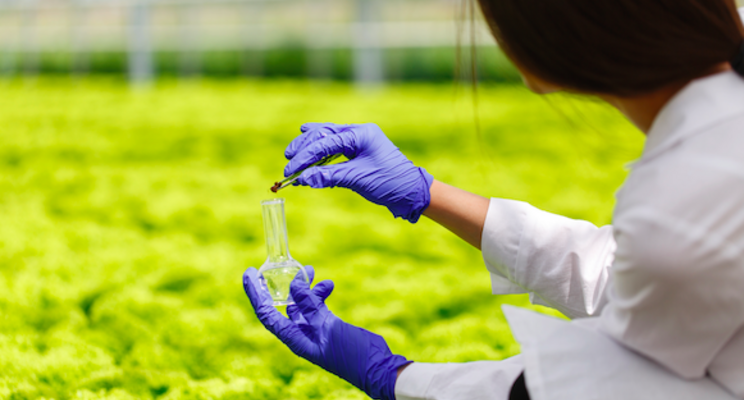First dicamba-resistant waterhemp reported in Illinois
Added on 06 December 2021

It's not a huge level of resistance, but there's a twist. The population had never been sprayed with dicamba or its relative 2,4-D, to which it is also resistant. So, why did waterhemp stop responding to these herbicides?
"When we use herbicides, we select for plants that can survive those herbicides through a variety of mechanisms. Historically, that was target-site mutation, but now, more and more, we're seeing metabolic resistance, where the weeds are activating detoxification genes before the chemicals can do harm. And so these weed populations are accumulating suites of genes that are active against various herbicides, and there's cross-reactivity," says Pat Tranel, professor in the Department of Crop Sciences at Illinois and co-author on the study.
Tranel and his colleagues already knew waterhemp in the Champaign County population was resistant to the synthetic auxin herbicide 2,4-D. Since dicamba is also a synthetic auxin, it's not that much of a stretch to imagine the detoxification pathway might be the same. But waterhemp in the study population resists herbicides in five other site of action groups, so cross-reactivity could have come from anywhere.
"As we get these more complex populations that have experienced selection from multiple chemistries, they are becoming resistant to broader and broader suites of herbicides, whether they've seen those herbicides in the past or not. That's a scary thought," Tranel says. It could mean new chemistries could be rendered ineffective before they even reach the shelves.
Origin of resistance aside, 65% control, particularly by a synthetic auxin, is not good enough.
"At 65-75% control, a farmer might not realize they're dealing with resistance and instead might just think they screwed up during application. Because they would see some activity. And these growth regulator herbicides can actually stimulate growth, causing the plant to twist up and thicken and never really die. They just kind of sit there," Tranel says. "That makes it harder to quantify resistance."
The researchers went to great lengths to document dicamba damage. In the field, they sprayed dicamba alone and in combination with other herbicides to quantify damage. And in the greenhouse, they conducted a dose-response experiment and determined heritability of the resistance trait across generations.
"Because auxin damage can be hard to gauge visually, I used an image analysis, taking more than 4,000 images from multiple angles. With that, I could train a model to say if the plants were resistant or not. It's really difficult, because even when we see damage, at the end many of the plants still flower. And if they flower, they produce seeds, and they will be a problem next year," says Lucas Kopecky Bobadilla, doctoral student and lead author on the study.
The researchers found dicamba resistance was moderately heritable, meaning it could be passed on to offspring at least some of the time. Tranel says those genes are incompletely dominant, which explains why the team saw a range of responses from sensitive-like to up to 10-fold resistant.
The team tested dicamba resistance in the same field back in 2014 and 2015, showing 80% efficacy. The decline to 65% just a few years later - the field work in the current study was done in 2018 - is not a good trend.
"It's safe to say dicamba isn't going to become more effective," says co-author Aaron Hager, associate professor and Extension specialist in crop sciences. "And once we find a resistant population, that doesn't mean there aren't others. All it means is we found one. We have no idea how common this is."
In fact, dicamba resistance was recently documented in a Tennessee waterhemp population, and in a Tennessee population of Palmer amaranth, an aggressive waterhemp relative. Hager and the team are currently testing another Illinois population with known exposure to dicamba.
Dicamba has been used in Illinois for at least 50 years. But with more acreage being planted in dicamba tolerant soybeans, use of the chemical is on the rise. And with increasing selective pressure, Hager says, dicamba resistance could spread quickly.
"We saw this decline to 65% control in a population that wasn't being managed with dicamba. If there was extensive selection through repeated dicamba application, I'm confident we would see an increase in the level of resistance in this population," Tranel says.
Hager and Tranel, along with the rest of the weed science team at Illinois, have been making the same recommendations for years.
"Look, we're going to continue to use herbicides on the vast majority of acres in this state. We're not going to stop," Hager says. "But it behooves people to really have some deep conversations with whoever's giving you recommendations, whether it's your input supplier, your agronomist, or whoever. It's time to go back to what we used to do and try to map out three or four year weed control programs and not just do this on a yearly basis."
And, he adds, "We're going to have to do something in addition to herbicides to try to get to the end of the growing season without any seed production. Anything short of that and evolution continues."
Click here to read more.
Photo created by freepic.diller - www.freepik.com
Source: Ag News
More news















